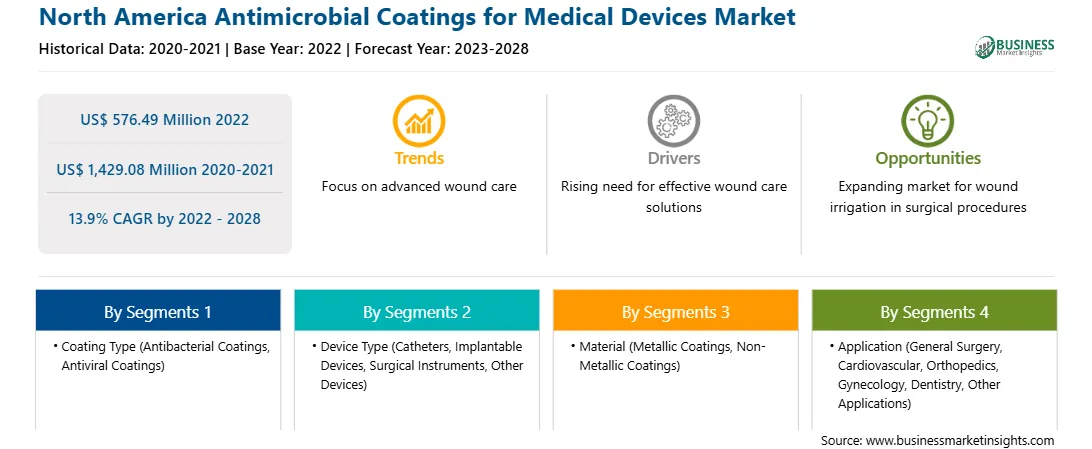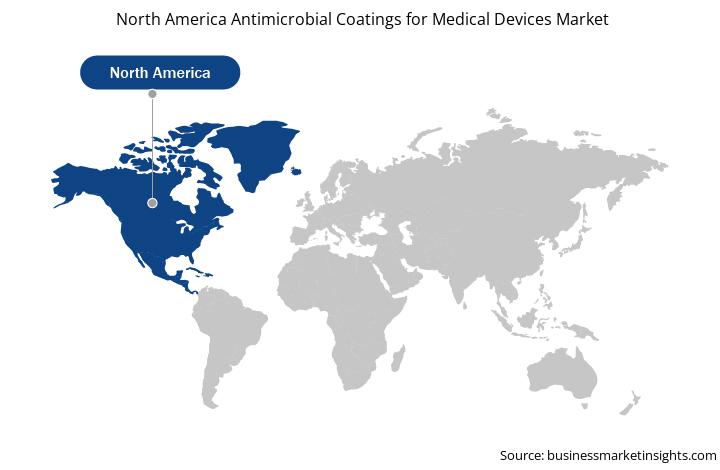North America Antimicrobial Coatings for Medical Devices Market
No. of Pages: 165 | Report Code: BMIRE00027704 | Category: Chemicals and Materials
No. of Pages: 165 | Report Code: BMIRE00027704 | Category: Chemicals and Materials
Healthcare-associated infections (HAIs) include catheter-associated urinary tract infections, central line-associated bloodstream infections, and ventilator-associated pneumonia. These infections may also occur at surgery sites and are known as surgical site infections. According to a report titled “2020 National and State Healthcare-Associated Infections Progress Report," published by the Centers for Disease Control and Prevention (CDC) in 2021, ~24%, 35%, and 15% rise was recorded in central line-associated bloodstream infections, ventilator-associated events, and Methicillin-resistant Staphylococcus aureus (MRSA) bacteremia, respectively, between 2019 and 2020 in the US. Moreover, as published in the January 2022 report by the National Healthcare Safety Network (NHSN), urinary tract infections (UTIs) are the fifth most common type of healthcare-associated infection. UTIs account for more than 9.5% of conditions reported by acute care hospitals. Catheter-Associated Urinary Tract Infection (CAUTI), one of the most common UTIs acquired in hospitals, is transmitted through urinary catheters that are placed to drain urine from the bladder. According to the Centers for Disease Control and Prevention (CDC) data published in 2020, ~75% of infections are associated with a urinary catheter. The most important risk factor leading to the development of CAUTI is the prolonged use of urinary catheters. ~15–25% of hospitalized patients receive urinary catheters during their hospital stays. Complications associated with CAUTI cause discomfort among patients, extending hospital stays and increasing treatment costs, further raising the possibility of mortality. According to the CDC, more than 13,000 deaths are annually associated with UTIs. Acute uncomplicated cystitis results in an estimated 6 days of discomfort, leading to approximately 7 million office visits per year with associated costs of US$ 1.6 billion. Thus, HAIs are imposing a high economic burden on healthcare systems. Coating medical devices with antimicrobial materials may help lower the occurrence of HAIs. Antimicrobial coatings, which are effective against a broad range of pathogens, can be applied to a wide range of surfaces and materials, e.g. polyurethane and silicone. Thus, the increasing incidence of CAUTI complements the rise in the use of antimicrobial coatings in North America.
Per the US Department of Health and Human Services, 1 out of every 25 hospitalized patients is affected by an HAI at any time in the country. In hospitals in the US, the CDC estimated that HAIs account for ~1.7 million infections and 99,000 associated deaths yearly. HAIs are common in all types of care settings, including acute care hospitals, ambulatory surgical centers, dialysis facilities, outpatient care (e.g., physicians' offices and health care clinics), and long-term care facilities (e.g., nursing homes and rehabilitation facilities). Therefore, the rising prevalence of HAIs, highlighting the need for antimicrobial coatings on medical devices, fuels the North America antimicrobial coatings for medical devices market.
Strategic insights for the North America Antimicrobial Coatings for Medical Devices provides data-driven analysis of the industry landscape, including current trends, key players, and regional nuances. These insights offer actionable recommendations, enabling readers to differentiate themselves from competitors by identifying untapped segments or developing unique value propositions. Leveraging data analytics, these insights help industry players anticipate the market shifts, whether investors, manufacturers, or other stakeholders. A future-oriented perspective is essential, helping stakeholders anticipate market shifts and position themselves for long-term success in this dynamic region. Ultimately, effective strategic insights empower readers to make informed decisions that drive profitability and achieve their business objectives within the market. The geographic scope of the North America Antimicrobial Coatings for Medical Devices refers to the specific areas in which a business operates and competes. Understanding local distinctions, such as diverse consumer preferences (e.g., demand for specific plug types or battery backup durations), varying economic conditions, and regulatory environments, is crucial for tailoring strategies to specific markets. Businesses can expand their reach by identifying underserved areas or adapting their offerings to meet local demands. A clear market focus allows for more effective resource allocation, targeted marketing campaigns, and better positioning against local competitors, ultimately driving growth in those targeted areas.
North America Antimicrobial Coatings for Medical Devices Strategic Insights

North America Antimicrobial Coatings for Medical Devices Report Scope
Report Attribute
Details
Market size in 2022
US$ 576.49 Million
Market Size by 2028
US$ 1,429.08 Million
Global CAGR (2022 - 2028)
13.9%
Historical Data
2020-2021
Forecast period
2023-2028
Segments Covered
By Coating Type
By Device Type
By Material
By Application
By End User
Regions and Countries Covered
North America
Market leaders and key company profiles
North America Antimicrobial Coatings for Medical Devices Regional Insights

The North America antimicrobial coatings for medical devices market is segmented into coating type, material type, device, material, application, end user, and country.
In terms of coating type, the market is segmented into antibacterial coatings, antiviral coatings, and others. The antibacterial coatings segment registered the largest market share in 2022.
The North America antimicrobial coatings for medical devices market by device type, is categorized into catheters, implantable devices, surgical instruments, and other devices. The catheters segment held the largest market share in 2022.
Based on material, the market is bifurcated into metallic coatings and non-metallic coatings. The metallic coatings segment held a larger market share in 2022.
In terms of application, the market is categorized into general surgery, cardiovascular, orthopedics, gynecology, dentistry, and other applications. The general surgery segment accounted for the largest market share in 2022.
The North America antimicrobial coatings for medical devices market by end user, is categorized into hospitals and clinics, diagnostic centers, ambulatory surgical centers, and others. The hospitals and clinics segment held the largest market share in 2022.
Based on country, the North America antimicrobial coatings for medical devices market is segmented into the US, Canada, and Mexico. The US dominated the market in 2022.
The Dow Chemical Company; PPG Industries, Inc.; Microban International; Sciessent LLC; Covalon Technologies Ltd.; DSM; Specialty Coating Systems Inc.; AST Products, Inc.; and Hydromer are among the leading companies operating in the antimicrobial coatings for medical devices market in North America.
The North America Antimicrobial Coatings for Medical Devices Market is valued at US$ 576.49 Million in 2022, it is projected to reach US$ 1,429.08 Million by 2028.
As per our report North America Antimicrobial Coatings for Medical Devices Market, the market size is valued at US$ 576.49 Million in 2022, projecting it to reach US$ 1,429.08 Million by 2028. This translates to a CAGR of approximately 13.9% during the forecast period.
The North America Antimicrobial Coatings for Medical Devices Market report typically cover these key segments-
The historic period, base year, and forecast period can vary slightly depending on the specific market research report. However, for the North America Antimicrobial Coatings for Medical Devices Market report:
The North America Antimicrobial Coatings for Medical Devices Market is populated by several key players, each contributing to its growth and innovation. Some of the major players include:
The North America Antimicrobial Coatings for Medical Devices Market report is valuable for diverse stakeholders, including:
Essentially, anyone involved in or considering involvement in the North America Antimicrobial Coatings for Medical Devices Market value chain can benefit from the information contained in a comprehensive market report.